Top Rankings
Dixon Elementary School District ranks among the top 20% of public school district in Montana for:
Category
Attribute
Science Proficiency
Highest science proficiency (Top 20%)
Diversity
Most diverse schools (Top 1%)
Student Attention
Lowest student:teacher ratio (Top 1%)
For the 2025 school year, there is 1 public middle school serving 9 students in Dixon Elementary School District. This district's average middle testing ranking is 10/10, which is in the top 10% of public middle schools in Montana.
Public Middle School in Dixon Elementary School District have an average math proficiency score of 50% (versus the Montana public middle school average of 33%), and reading proficiency score of 50% (versus the 47% statewide average).
Minority enrollment is 89% of the student body (majority American Indian), which is more than the Montana public middle school average of 23% (majority American Indian).
Overview
This School District
This State (MT)
# Schools
2 Schools
331 Schools
# Students
44 Students
34,525 Students
# Teachers
9 Teachers
2,568 Teachers
Student : Teacher Ratio
5:1
5:1
District Rank
Dixon Elementary School District, which is ranked within the bottom 50% of all 347 school districts in Montana (based off of combined math and reading proficiency testing data) for the 2021-2022 school year.
Overall District Rank
#302 out of 350 school districts
(Bottom 50%)
(Bottom 50%)
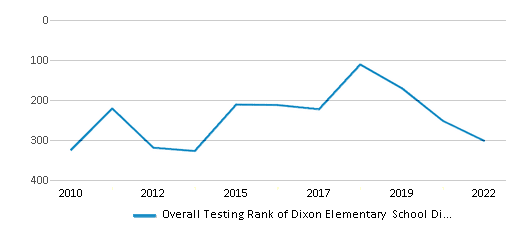
Math Test Scores (% Proficient)
11-19%
35%
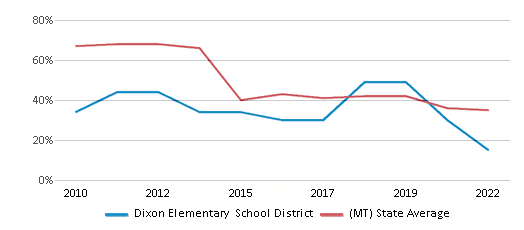
Reading/Language Arts Test Scores (% Proficient)
30-39%
46%
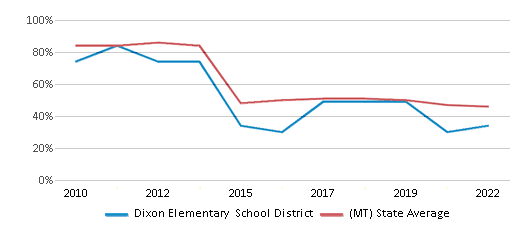
Science Test Scores (% Proficient)
<50%
37%
Students by Ethnicity:
Diversity Score
0.60
0.39
# American Indian Students
22 Students
3,906 Students
% American Indian Students
50%
11%
# Asian Students
n/a
202 Students
% Asian Students
n/a
1%
# Hispanic Students
1 Student
1,953 Students
% Hispanic Students
2%
6%
# Black Students
n/a
236 Students
% Black Students
n/a
1%
# White Students
17 Students
26,582 Students
% White Students
39%
77%
# Hawaiian Students
n/a
63 Students
% Hawaiian Students
n/a
n/a
# Two or more races Students
4 Students
1,583 Students
% of Two or more races Students
9%
4%
Students by Grade:
# Students in PK Grade:
-
63
# Students in K Grade:
6
440
# Students in 1st Grade:
6
446
# Students in 2nd Grade:
6
428
# Students in 3rd Grade:
6
470
# Students in 4th Grade:
4
567
# Students in 5th Grade:
1
1,752
# Students in 6th Grade:
6
7,409
# Students in 7th Grade:
6
11,480
# Students in 8th Grade:
3
11,296
# Students in 9th Grade:
-
49
# Students in 10th Grade:
-
42
# Students in 11th Grade:
-
41
# Students in 12th Grade:
-
42
# Ungraded Students:
-
-
District Revenue and Spending
Total Revenue
$1 MM
$2,285 MM
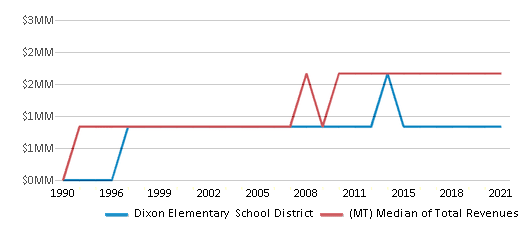
Spending
$1 MM
$2,298 MM
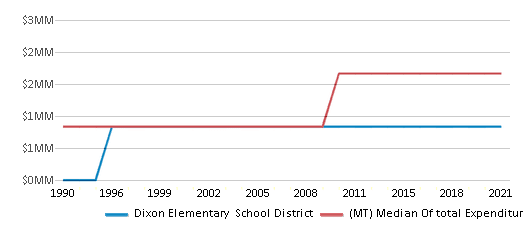
Revenue / Student
$23,096
$18,438

Spending / Student
$25,942
$17,330
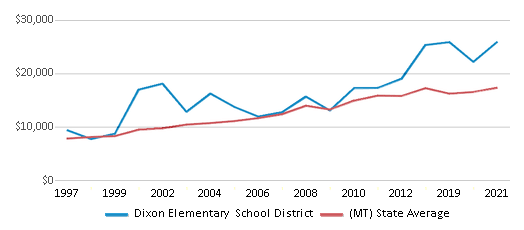
Best Dixon Elementary School District Public Middle Schools (2025)
School
(Math and Reading Proficiency)
(Math and Reading Proficiency)
Location
Grades
Students
Rank: #11.
Dixon 7-8
(Math: <50% | Reading: ≥50%)
Rank:
Rank:
9/
Top 20%10
411 B Street
Dixon, MT 59831
(406) 246-3566
Dixon, MT 59831
(406) 246-3566
Grades: 7-8
| 9 students
Recent Articles

The Impact of Coronavirus on Public Schools
This article discusses the widespread impact of COVID-19 on public schools, addressing issues such as school closures, remote learning challenges, effects on standardized testing, and concerns about student progress. It also provides tips for parents suddenly faced with homeschooling responsibilities.

What Public School Students Should Expect After COVID-19
In this article, we’ll take a closer look at the financial impact of COVID-19 on public schools and what to expect in the future. We’ll talk about the effects of budget cuts and other challenges affecting the public school system for the remainder of this school year and into the next.

February 05, 2025
Understanding the U.S. Department of Education: Structure, Impact, and EvolutionWe explore how the Department of Education shapes American education, from its cabinet-level leadership to its impact on millions of students, written for general audiences seeking clarity on this vital institution.





